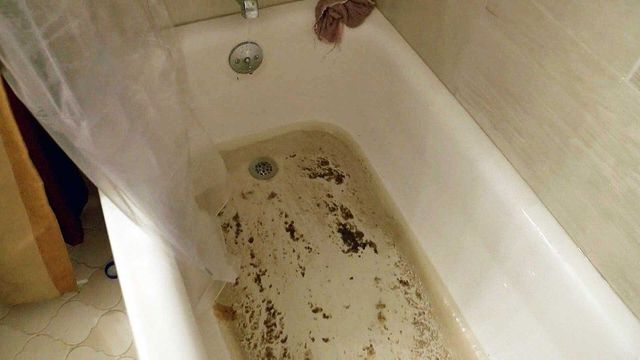This post listed below on the subject of Why is Sewage Backing Up Into My Bathtub? is incredibly enlightening. You should keep reading.

Sewage backup in the bath tub can be a distressing and unhygienic problem for any type of homeowner. Not only is it bothersome, but it likewise postures severe health risks and indicates underlying concerns with the plumbing system. Recognizing why sewer is showing up through the tub is important for taking ideal action to deal with the problem successfully.
Intro to the Issue
Common Reasons for Sewage Back-up
Clogs in the Drain Line
One of the most typical sources of sewer back-up is a clog in the sewage system line. This can happen because of the build-up of debris, grease, or foreign objects in the pipes, protecting against correct flow and creating sewer to back up right into your bath tub.
Tree Root Intrusion
Tree origins looking for wetness and nutrients can infiltrate sewage system lines with small splits or joints. Gradually, these roots can expand and increase, triggering substantial damages to the pipes and causing sewage back-up issues.
Recognizing the Issue
When sewage starts backing up right into the bathtub, it's a clear indication of a problem with the drainage system. The wastewater that must be streaming far from your home is rather finding its way back into your space, which can result in substantial damage and health hazards.
Possible Causes
A number of variables can contribute to sewage backup in the tub. From clogs in the drain line to problems with the plumbing facilities, recognizing the origin is vital for discovering a remedy.
Aging Framework
Older homes might have obsoleted plumbing systems that are extra vulnerable to rust, cracks, and wear and tear. As pipes age, they become more prone to leakages and blockages, raising the chance of sewer backup incidents.
Heavy Rainfall or Flooding
Throughout durations of heavy rainfall or flooding, the sewer system may come to be overwhelmed with excess water, causing back-ups and overflows. This can lead to sewage supporting into bath tubs and various other fixtures inside the home.
Indicators of Sewage Back-up
Foul Odors
Undesirable odors originating from drains or components, especially in the washroom, may show sewage back-up issues. These odors are frequently solid and persistent, indicating a trouble that calls for immediate attention.
Slow Draining Fixtures
Tubs, sinks, and commodes that drain pipes slowly or otherwise at all could be experiencing sewer backup. If several fixtures are affected all at once, it's likely that the problem stems from a common point, such as the primary drain line.
Gurgling Noises
Odd gurgling or gurgling noises coming from drains pipes when water is running elsewhere in your house are a sign of air entraped in the plumbing system. This air build-up can arise from sewage back-up and must be examined promptly.
Wellness Threats Associated with Sewage Back-up
Contamination of Supply Of Water
Sewage backup can pollute the water in your house, positioning a significant health and wellness danger to you and your family. Direct exposure to polluted water can lead to stomach problems, skin infections, and other ailments.
Mold Growth
Dampness from sewage back-up can create ideal problems for mold growth in your home. Mold and mildew spores can aggravate respiratory issues and create allergic reactions in delicate individuals, making timely cleanup necessary.
Spread of Illness
Sewer has damaging germs, viruses, and bloodsuckers that can trigger a variety of conditions, including hepatitis, cholera, and gastroenteritis. Entering contact with sewage or polluted surface areas puts you in danger of infection.
Cleaning Up After Sewage Backup
Sanitation Procedures
Extensively decontaminate and disinfect influenced locations after sewer back-up to get rid of unsafe bacteria and prevent mold development. Usage proper cleansing products and protective gear to guarantee safe and effective cleaning.
Repair of Impacted Areas
Fix any kind of damages to flooring, wall surfaces, or components triggered by sewer back-up. Depending on the extent of the damages, you may require to replace carpeting, drywall, or various other materials to recover your home to its pre-loss condition.
Immediate Actions to Take
Switching Off Water
In the event of sewer backup, it's important to turn off the water system to prevent additional contamination and damage. Locate the primary water shutoff valve in your home and closed it off until the problem can be solved.
Speaking To a Specialist Plumber
Managing sewer back-up is not a DIY task. Get in touch with an accredited plumber with experience in handling sewage-related issues to assess the scenario and do essential repair services or cleanups.
Staying Clear Of Contact with Contaminated Water
Up until the sewage back-up is fixed, prevent contact with infected water to stop the spread of bacteria and pathogens. Use protective gear if you have to be in the damaged area and wash your hands thoroughly later.
Preventive Measures
Routine Upkeep of Sewage System Lines
Arrange normal inspections and upkeep of your sewage system lines to determine and deal with prospective issues before they intensify into significant problems. This can include clearing out particles, examining for tree root invasion, and repairing any damaged pipelines.
Mounting Backwater Shutoffs
Take into consideration installing backwater shutoffs in your plumbing system to avoid sewage from flowing back into your home during periods of heavy rainfall or flooding. These valves automatically close when water draws back up, securing your residential property from contamination.
Correct Disposal of Home Waste
Prevent flushing anything besides toilet tissue and human waste down the bathroom to stop clogs and blockages in the sewer line. Dispose of oil, oil, and other house chemicals properly to decrease the risk of plumbing issues.
Why is there sewage coming up from my bathtub?
These gas fumes, like hydrogen sulfide – the gas that leaves a rotten egg smell in its wake and is highly flammable and toxic – can be hazardous to your health. Sewage poses major health risks as it contains harmful bacteria and microorganisms that can be dangerous if exposed to them.
Sewage cleanup should be considered an emergency.
So, why is there sewage coming up from your bathroom? There are several common causes of a sewage backup.
The most common reason for sewage coming up through your bathroom is a clogged sewer line. All plumbing in your bathroom connects to a single drain pipe that leads to the sewer line under your house. This drain line carries all wastewater and sewage away from your home to the city’s sewer system.
When the sewer line becomes clogged or blocked, wastewater has nowhere to go but back toward your house. This results in sewage coming up through your drains, often starting with your tub or shower.
Another culprit may be the sewage ejector pump, which is used when a bathroom, laundry room or any other type of plumbing fixture is located below the level of the main sewer or septic line flowing from the house. Most commonly, ejector pumps are used in homes with basement bathrooms or laundry rooms.
When you experience sewage coming up through your bathtub, it’s always best to contact a professional. Attempts to fix a clogged sewer line without experience often lead to more plumbing damage.
Make sure that no one enters the affected area, and open as many windows as possible. Pre-treat the flooded area with small splashes of chlorine bleach. Wear protection gear like rubber gloves, a mask, and water-resistant coveralls.
https://www.shawlocal.com/the-herald-news/sponsored/2022/08/17/omega-plumbing-10199038/

We were shown that article on through someone on another web blog. Sharing is good. Helping others is fun. Thanks a lot for going through it.
Schedule Service